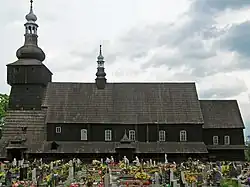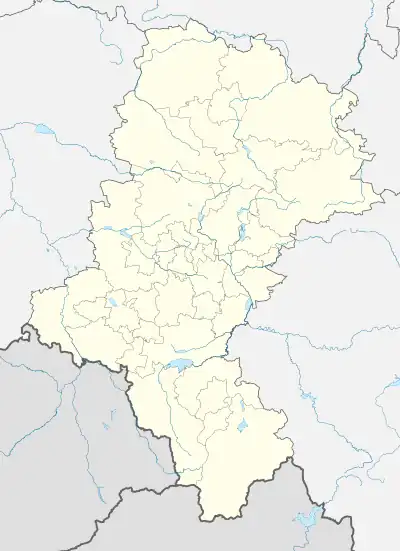Miedźna
Miedźna [ˈmʲɛd͡ʑna] is a village in Pszczyna County, Silesian Voivodeship, in southern Poland. It is the seat of the gmina (administrative district) called Gmina Miedźna.[1] It lies approximately 8 kilometres (5 mi) east of Pszczyna and 30 km (19 mi) south of the regional capital Katowice.
Miedźna | |
|---|---|
Village | |
 Saint Clemens church | |
 Miedźna  Miedźna | |
| Coordinates: 49°59′N 19°3′E | |
| Country | |
| Voivodeship | Silesian |
| County | Pszczyna |
| Gmina | Miedźna |
| Population | 1,576 |
| Time zone | UTC+1 (CET) |
| • Summer (DST) | UTC+2 (CEST) |
| Vehicle registration | SPS |
| Voivodeship roads | |
| Website | http://www.miedzna.pl/ |
History
In the Middle Ages, the area was part of the territory of the Vistulans tribe, one of the Polish tribes.[2] It became part of the emerging Polish state in the 10th century. As a result of the fragmentation of Poland, it was part of the Polish Seniorate Province and Duchy of Racibórz. The village was first mentioned in 1326 in the register of Peter's Pence payment among Catholic parishes of Oświęcim deaconry of the Diocese of Kraków under two names: Medzwna seu Cuncendorf.[3]
Afterwards, the village passed under Bohemian (Czech) suzerainty, and in the 15th century, it became part of the newly formed Duchy of Pszczyna. During the political upheaval caused by Matthias Corvinus the duchy was overtaken in 1480 by Casimir II, Duke of Cieszyn from the Piast dynasty, who sold it in 1517 to the Hungarian magnates of the Thurzó family, forming the Pless state country. In the accompanying sales document issued on 21 February 1517 the village was mentioned as Medna.[4] Along with the Kingdom of Bohemia in 1526, it became part of the Habsburg monarchy. In the War of the Austrian Succession most of Silesia was conquered by the Kingdom of Prussia, including the village, and in 1871 it became part of the German Empire. After World War I, Poland regained independence, and following the subsequent Polish Silesian Uprisings against Germany, the village was reintegrated with the reborn Polish state.
During the German occupation (World War II), in January 1945, the death march from the Auschwitz concentration camp passed through Miedźna, and 42 prisoners, including 29 women and several children were buried in the village.[5]
References
- "Central Statistical Office (GUS) - TERYT (National Register of Territorial Land Apportionment Journal)" (in Polish). 2008-06-01.
- Orlik, Zygmunt (2012). Poręba: z życia podpszczyńskiej wsi (in Polish). Pszczyna: Towarzystwo Miłośników Ziemi Pszczyńskiej. p. 13. ISBN 978-83-62674-16-9.
- Jan, Ptaśnik (1913). Monumenta Poloniae Vaticana T.1 Acta Camerae Apostolicae. Vol. 1, 1207-1344 (in Latin). Cracoviae: Sumpt. Academiae Litterarum Cracoviensis. pp. 147–150.
- Musioł, Ludwik (1930). "Dokument sprzedaży księstwa pszczyńskiego z dn. 21. lutego 1517 R." Roczniki Towarzystwa Przyjaciół Nauk na Śląsku. Katowice: nakł. Towarzystwa ; Drukiem K. Miarki. R. 2: 235–237. Archived from the original on 11 September 2014. Retrieved 12 September 2014.
- "Szlakiem Marszów Śmierci". Miejsce Pamięci i Muzeum Auschwitz-Birkenau (in Polish). Retrieved 3 July 2021.
